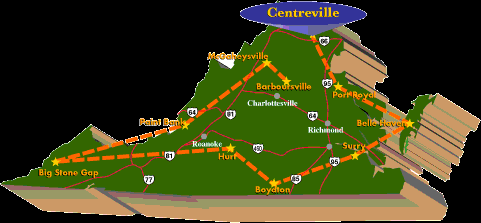
Download
in PDF Format
Centreville
was chartered in 1792.and has a population of 48,661.
Centreville in sprawling Fairfax County
can be a difficult place to define.
There is a post office and a zip code.
There are two Centreville exits on I-66. Yet even longtime residents
can�t always agree about the geographic area that Centreville entails.
Pat Lawless, a real estate broker and
one of the founders of the Centreville Community Foundation, says that
Centreville is bounded by the Prince William County line on the west and
south, Braddock Road on the north and �the old creek beds� toward the
community of Clifton to the east.
�Route 29 is Centreville�s Main
Street,� Lawless adds.
|
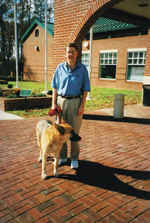
Supervisor
Michael Frey and his German Shepherd, Marley, at the entrance of
the Westfields Government Center. Marley sepnds each day in Frey's
district office. |
Michael Frey, Fairfax County supervisor,
is confident that all of Centreville lies within his Sully District and
notes that Centreville has been divided into four quadrants by I-66 and
routes 28 and 29. �The historic area of Centreville is tucked back off
of two major highways,� Frey explains.
It is the rich history of the original
town settled in the early 1700s that Frey and a core group of local
residents are working to preserve in the midst of astounding growth. What
was a sleepy farming community of less than 500 in the 1940s, his Western
Fairfax district is now home to over 150,000 people � a 63 percent
increase in population in the past 10 years.
At Mountain View School, an alternative
high school in Centreville, history and government teacher Geneva Lindner
and guidance counselor Sharon DeBragga have begun a unique project to
spark the interest of their students in the history of the area. The
students have toured historic sites and conducted interviews with lifelong
residents.
|

Lindner's
history and government students at Mountain View School are
learning about Centreville through their oral history class
project. |
In one interview, the students were
surprised to learn that Centreville, only 25 miles from the nation�s
capital, had no electricity until 1941 when lines were strung by Prince
William Electric Cooperative. Today, Northern Virginia Electric
Cooperative (NOVEC) continues to provide power for much of the area.
Established as the community of Newgate
by the British Parliament in 1742, the area was first farmed by a mix of
tenants and convicts released from England�s famed Newgate Prison. Town
fathers sought to change the name and obtained a new charter as
Centreville in 1792.
|
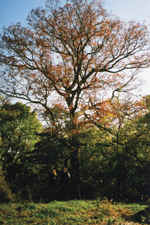
DeBragga
and Lindner are dwarfed by the huge 200-year-old oak tree that was
once one of seven lining the entrance to Royal Oaks. |
�Centreville drew its name from the
fact that it seemed to be in the center of things,� says developer,
realtor and historian Dennis Hogge, who notes that George Washington
stopped at least four times at one of the town�s taverns, or
�ordinaries,� as did Thomas Jefferson en route to his inauguration.
DeBragga and Lindner and their students
recently wrote and published a booklet, �Welcome to Centreville � Your
Passport to Local History,� that gives a guided tour in text and photos
of landmarks such as Braddock Road, the Royal Oaks Site, St. John�s
Episcopal Church, the Old Stone Church and Mt. Gilead.
|
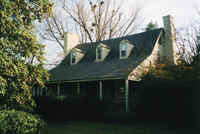
Mount
Gilead, built around 1780, was once known as "The Ordinary
the the Black Horse" and offered meals and lodging to
Colonial-era travelers. |
Mt. Gilead, built around 1780, is in the
heart of Centreville�s historic district. From 1785 to 1789, the
two-story structure was known as �The Ordinary of the Black Horse� and
served meals and offered lodging to travelers. An excellent example of
Potomac River architecture, the house and its beautiful grounds are now
owned by the Fairfax County Park Authority.
Every September, the Centreville
Community Foundation holds Centreville Day. This year, for the first time,
the celebration was held at Mt. Gilead. As part of Centreville Day, Sharon
DeBragga and Geneva Lindner present a play they wrote about
Centreville�s history. Local residents, many of whom are fellow teachers
recruited from Mountain View School, dress in period costume to represent
historic figures from John Smith to Civil War generals.
DeBragga and Lindner delight in taking
visitors on a walking tour of the historic area that still has the look of
a rural village, while the sounds of heavy construction equipment can be
heard as new town homes are being built less than a half-mile away.
They point out a huge 200-year-old oak
that was once one of seven trees that lined the entrance to Royal Oaks,
the home of Centreville�s founder and Revolutionary War patriot John
Orr. During the Civil War, General John S. Mosby used Royal Oaks as a safe
house and meeting place. In 1959, the home was dismantled and moved to a
Fauquier County farm. The remains were recently rediscovered and there is
hope that funds can be raised to rebuild the house on the original site.
|
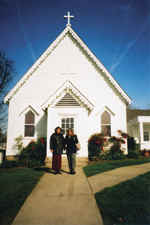
Geneva
Lindner and Sharon DeBragga pause at St. John's Episcopal Church. |
Situated so near Manassas, Centreville
is rich in Civil War history. Royal Oaks was also used as headquarters for
Union generals McDowell and Pope during the battles of Bull Run. St.
John�s Episcopal Church was used as a hospital and campground for troops
of both sides. The cemetery on the church grounds is the resting place of
many fallen Confederate soldiers.
Michael Frey relates how the Civil War
decimated Centreville. Many of its original buildings were burned, as were
the fertile farmlands. �After the war, the need to rebuild was so
desperate that not a tree was left around Centreville,� Frey says.
In fact, the original St. John�s
Church burned and was rebuilt in 1867 using whatever lumber the builders
could scrounge. In the ceiling above the pulpit, one can still see the
keyhole of a door that was used.
Frey and community leaders envision Mt.
Gilead as the centerpiece of a preserved historic village, �a mini
village green� with the remaining buildings restored to their original
state as was done in Colonial Williamsburg.
�With the increasing suburbanization
of Fairfax County, people need a feeling of roots and are becoming more
interested in history,� explains Frey, noting that Centreville�s
multiple historic structures are �unique in the county� and deserve
preservation.
Frey says that he and the citizens of
Western Fairfax County are working to balance the growth of the area
without damaging its economic vitality. �We want to discourage commuter
traffic through the heart of Centreville,� the supervisor says, �while
making sure there is enough traffic to assure the success of retail
businesses in the area.�
Frey proudly notes that the county has
been aggressive in acquiring and developing parklands and green spaces.
Fairfax recently acquired 2,200 acres called the Sully Woodlands, near
Historic Sully Plantation, the home of Richard Bland Lee, Northern
Virginia�s first congressional representative and uncle of the Civil War
general. �This is the largest single purchase of parkland in the
county�s history,� Frey says.
Living in the shadow of Washington,
D.C., and with its attractiveness as a location for headquarters of major
corporations and technology companies that want to be near the capital, it
is unlikely that the rapid growth of Centreville and Fairfax County will
subside. Yet even as town houses and shopping centers seem to sprout from
the ground overnight, among its residents there is a real commitment to
keeping alive the history, the spirit and farming village roots of
Centreville.
|
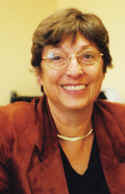
"It's
the spirit of a town that makes a town," says Pat Lawless,
who manages a bustling real estate office with over 150 agents. |
�It is the spirit of a town that
creates a town,� says Pat Lawless. �Without this community spirit,
Centreville would become just another spot on the map.�
One way the Centreville Community
Foundation is working to create a sense of community is through its Web
site, www.centreville.org, which Lawless calls
�our electronic town hall.� She credits local resident Brad
Thompson who helped develop and acts as Web master for the site. Lawless
also cites CentreView, a weekly newspaper that chronicles events and
people in Centreville.
�We�re providing opportunities for
people to get involved, so they don�t feel disconnected,� Lawless
says.
With such a wealth of true community
spirit, the question, �Where is Centreville?� is really not one of
geographic boundaries. Centreville lives in the hearts of those live and
raise their families in this thriving community and are working so hard to
preserve its history and heritage.